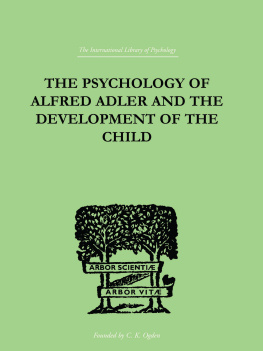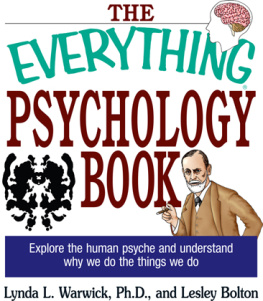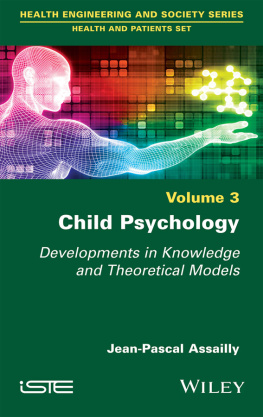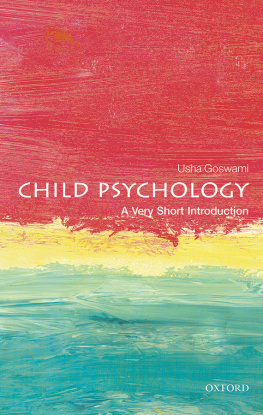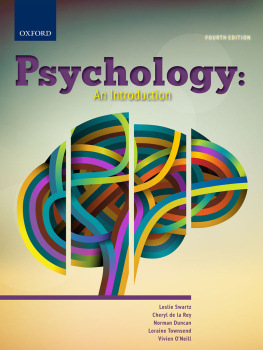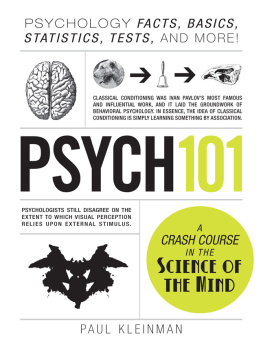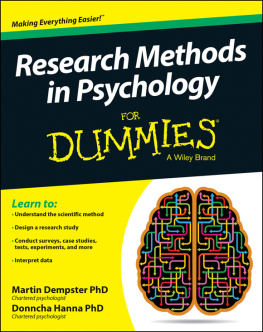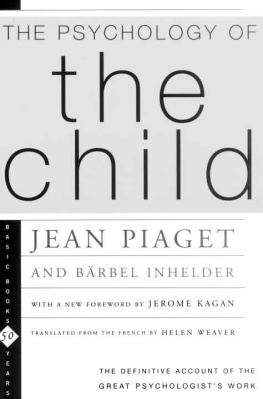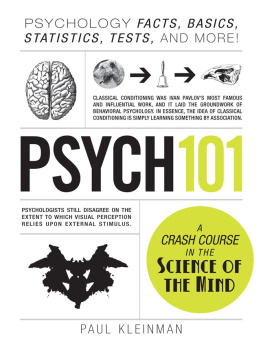Child Psychology Primer
Child Psychology Primer
George Hollich
Purdue University, Department of Psychological Sciences
Copyright 2015 by George Hollich. All rights reserved.
This book is licensed for your personal enjoyment only. This book may not be re-sold or given away to other people. If you would like to share this book with another person, please purchase an additional copy for each reader. If youre reading this book and did not purchase it, or it was not purchased for your use only, then please return to your favorite retailer and purchase your own copy. Thank you for respecting the hard work of this author.
Copyright holder has no responsibility for the persistence or accuracy of URLs for external or third-party Internet websites referred to in this publication and does not guarantee that any content on such websites is or will remain accurate, appropriate, or accessible.
Effort has been made to ensure that the pages of this publication are accessible to individuals with disabilities. If you have any comments or questions on accessibility issues relating to this publication, please contact .
for you...
TABLE OF CONTENTS
A TALE OF TWO CHILDREN
This is a story about two children who could not be more different if they tried. While one was good and sweet, the other was mean and spiteful. While one was caring, considerate, and respectful of others, the other was selfish, thoughtless, and aggressive. It should come as no surprise that their trajectories in life were very different: the sweet one grew up to be healthy and socially well adjusted, and became a productive member of society. The other grew up to be twisted and unloved and was ultimately incarcerated to the end of days for crimes so appalling that I wont turn your stomach by describing them in detail here.
So how did this happen? How did two beautiful babies from a similar time and place come to such very different ends? Was it their parents or their teachers? Was it a doctor, psychologist, or clinician who made all the difference? Maybe it was some combination of all of these mixed with cultural influences, a dash of media exposure, and a confluence of circumstances impossible to escape for either child. Perhaps.
Or maybe it was you! Maybe it was something you did or said. Have you ever thought about that? Not to be alarmist, but all of us come into contact with children at one time or another and their olderhopefully more matureincarnations. What difference will you make? How have you changed the life trajectory of the people youve met? If life is the sum total of all our interactions, then it is very possible that the cumulative total of your interactions is slowly changing the lives of all the children youve ever met. Is the difference you're making a positive one?
Do you even know what to do? Children are not like us. They don't think the same way; they dont react in the ways we expect. In fact, sometimes the most logical, sensible reaction is the worst possible in terms of long-term outcomes. You might be screwing up childrens lives without even knowing it!
Relax. This primer aims to help. It will give you essential knowledge and help you master the key things you need to know to understand from a scientific viewpoint why children turn out the way they do. In the process, you will get practice figuring out what to do based on what actually works according to the data (rather than what people think works). This book will put you on the path to asking the right questions and give you an empirical foundation for figuring out what really works and what doesnt.
In this manner, you will soon discover that this primer isnt like any textbook you have encountered before. Its an antitextbook, in fact. Most textbooks try to pack the maximum amount of information in the minimum amount of space. This can be a problem because, to paraphrase the supervillain Syndrome from The Incredibles, when everything is important, nothing is important. Knowledge has a way of making people want to share it. The more you know, the more you want to sharewhich explains why college professors write so much! Unfortunately, by trying to teach everything, most textbooks wind up teaching nothing.
This primer aims to give you just the bare essentials: the key concepts, methods, and findings that you simply have to know to usefully apply child psychology in your own life. This primer is the CliffsNotes version of child psychology. It will give you the essence of what child psychology is all about and then give you some suggestions for how you might apply it.
With this minimalist goal in mind, each chapter starts with a short summary of what you will learn, dives into the foundational concepts (the terms and ideas you must know) and the critical methods and findings (the research that youll want to tell your friends about), and then finishes with a section on why this matters, which includes discussion of practical applications of this knowledge in the home, the classroom, and health care settings as well as cross-cultural differences and similarities.
Much like priming a water pump or laying down a coat of paint primer, I want this book to serve as a jumping-off point for future exploration, and as an added benefit, it costs a fraction of what textbooks normally cost. If you are interested in learning more, I provide helpful links to the references, and all the latest in cutting-edge research on the companion website to this book, childprimer.com . There you also will find some great videos, a few embarrassing pictures of me as a child, and links to reflective surveys and quizzes designed to solidify your learning. You may also post your own questions and get answers from me and other readers.
Through the website, you will discover that you will not take this journey alone. Others have taken this path before. Like you, they didnt always know what to do, but nowbecause of some scientific experimentationthey have learned some secrets that they will share and will help you avoid their mistakes, and you may help them. Together you will make tomorrows children sweet, caring, considerate, happy, healthy, well-adjusted members of societyat least thats the idea. Good luck.
George Hollich, Ph.D.
West Lafayette, Indiana, 2015
1. RESEARCH IN CHILD PSYCHOLOGY
Wow, my baby sure is ugly!
said no momma, ever
Child psychology has some of the cutest test subjects imaginable. Aww, look at the pretty baby! But as scientists, we arent content to simply look at that cuteness; we want to answer scientific questions such as how , when , and why . How do babies get to be so cute? Maybe it is their parents genes? When did they get to be so cute? At birth most babies really dont look so hot, but sometime between the birth and the millisecond after we see them, we love our children anyway. Why do we find babies so cute? Maybe because if they werent, we wouldnt take care of them.
Child psychology examines how who we were determines who we become. This chapter looks at the specific ways we use to study child psychology and introduces a system for getting answers that has worked for physicists, engineers, doctors, and even great polymaths such as Leonardo DaVinci. We use the scientific method.
1.1. Summary and objectives: How do psychologists study development?
Everyone has a pet theory about why kids behave the way they do, but as scientists, we want predictable, testable, and consistently reproducible descriptions and explanations for the causes of child behavior. Sure, parents could be responsible for producing little brats, but as scientists, we want more than a hunch based on a few striking examples. We want evidence! We need to look for cause and effect. If a parent does this, then a child will behave in this way. We also need to settle on a few key terms so everyone can be talking about the same thing. This chapter will give you the lay of the land. It starts by talking about the different stages of development and how we classify them and finishes by talking about the methods we use to help us definitively look for the causes (and cures) for behavior. By the end of this chapter you should be able to


